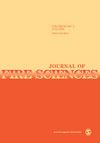Analysis of solid combustion products to establish a theoretical model of the causes of thermal runaway of ternary lithium-ion battery overcharge and heating
IF 1.9
4区 工程技术
Q2 ENGINEERING, MULTIDISCIPLINARY
引用次数: 1
Abstract
It is difficult to determine whether ternary lithium-ion batteries (t-LIBs) were the “source” of the actual fire scene because of the little available direct evidence left after thermal runaway combustion of lithium-ion batteries (LIBs) and the lack of relevant analytical methods for t-LIBs after complete combustion. As a result, a large number of fires involving t-LIBs are controversially identified as the cause every year. In this paper, we conducted experiments on the two most common thermal runaway types of t-LIBs to investigate the correlation model between their combustion products and thermal runaway types. In the case of overcharge, the combustion products (black powder) of t-LIBs contain aluminum elements, which may be due to the thermal reaction of aluminum. In contrast, in the case of heating, the combustion products of t-LIBs have almost no detectable elemental aluminum. The reason may be due to the ability of the electrode material to continuously decompose and precipitate a large amount of metal oxides under the overcharge condition, which constitutes the condition for the occurrence of the aluminum thermal reaction, making the presence of Al2O3 in the combustion products. However, the lack of continuous current action under the heating condition prevents the generation of the aluminum thermal reaction.固体燃烧产物的分析建立三元锂离子电池过充发热热失控原因的理论模型
由于锂离子电池(LIBs)热失控燃烧后几乎没有可用的直接证据,并且缺乏完全燃烧后t-LIBs的相关分析方法,因此很难确定三元锂离子电池是否是实际火灾现场的“来源”。因此,每年都有大量涉及t-LIBs的火灾被有争议地确定为原因。在本文中,我们对两种最常见的热失控类型的t-LIBs进行了实验,以研究其燃烧产物与热失控类型之间的相关性模型。在过度充电的情况下,t-LIBs的燃烧产物(黑色粉末)含有铝元素,这可能是由于铝的热反应。相反,在加热的情况下,t-LIBs的燃烧产物几乎没有可检测的元素铝。原因可能是电极材料在过充电条件下连续分解和沉淀大量金属氧化物的能力,这构成了铝热反应发生的条件,使得燃烧产物中存在Al2O3。然而,在加热条件下缺乏连续电流作用防止了铝热反应的产生。
本文章由计算机程序翻译,如有差异,请以英文原文为准。
求助全文
约1分钟内获得全文
求助全文
来源期刊

Journal of Fire Sciences
工程技术-材料科学:综合
CiteScore
4.00
自引率
0.00%
发文量
14
审稿时长
2.5 months
期刊介绍:
The Journal of Fire Sciences is a leading journal for the reporting of significant fundamental and applied research that brings understanding of fire chemistry and fire physics to fire safety. Its content is aimed toward the prevention and mitigation of the adverse effects of fires involving combustible materials, as well as development of new tools to better address fire safety needs. The Journal of Fire Sciences covers experimental or theoretical studies of fire initiation and growth, flame retardant chemistry, fire physics relative to material behavior, fire containment, fire threat to people and the environment and fire safety engineering. This journal is a member of the Committee on Publication Ethics (COPE).
 求助内容:
求助内容: 应助结果提醒方式:
应助结果提醒方式:


